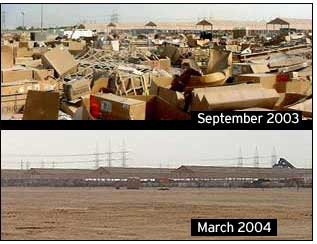The amount of supplies needed to feed, cloth and arm more than 100,000 soldiers in Iraq is huge. The Theater Distribution Center (TDC), located close to Camp Doha in Kuwait, was struggling to keep up with the flow of goods. But after the U.S. Army’s Product Manager for the Automatic Identification Technology (PM AIT) provided the distribution center with RFID capabilities, the facility is no longer a bottleneck for supplies moving into Iraq.
The TDC in Kuwait is the linchpin for Iraq-bound cargo moving from Kuwaiti seaports and a military airport. Many pallets are stacked with goods intended for a specific unit. Other pallets must be broken down, reassembled and before being shipped on to Iraq. But the TDC had no technology to identify pallets coming or going. The facility’s large open field became a jumble of supplies, equipment and boxes.
PM AIT, which provides auto-ID technologies to the U.S. Department of Defense, the U.S. Coast Guard and federal agencies, was brought in to help speed the movement of goods through the facility. Since there were no computers or even electricity in the area where pallets were broken down and reconstituted, the PM AIT brought in a trailer that could serve as an office with computers and set up a generator to provide power.
The computers run the Army’s Automated Manifest System (AMS), a software application that allows soldiers breaking down pallets at the Kuwaiti distribution center to scan the bar codes on cases of items as they are put on a new pallet or in a new container.
The bar codes on military shipping labels contain information that identifies the items contained in the cases—military suppliers use something called the National Stock Number to identify items—the number of items in a case and the destination of the cases. This information is downloaded from the handheld scanner when the scanner is placed in a cradle attached to a PC.
The PC also has an RFID reader that can write data to an active (battery-powered) RFID tag. Affixed to the pallet or container, the tag is read at the distribution center as the goods are leaving, at the Kuwait-Iraq border and at various checkpoints within Iraq until the goods arrive at an in-theater distribution center in Balad, Iraq. Each time the tags are read, the location and identification of the tag is uploaded to the military’s secure In-Transit Visibility system, a global network that enables the military to scan bar codes and read RFID tags on supplies and upload information about the supplies and their location to a secure database.
“We had facilities in Iraq for reading RFID tags, but we had no tags to be read—at least not on reconsolidated loads coming through the distribution center in Kuwait,” says Harry Meisell, PM AIT’s head of RFID operations for the U.S. military and NATO. “The hardware and software installed in Kuwait gave us the ability to put new tags onto the new loads at the distribution center to provide in-transit visibility so soldiers at supply points in Iraq and back at headquarters could track the flow of goods.”
The new system has dramatically speeded up the movement of goods. There are no longer piles of boxes waiting to be put on pallets and shipped on to Iraq. The field has been cleared. Pallets are quickly reconstituted and moved out of the facility. Soldiers working at the supply point in Balad can log on to secure servers and see what goods have left Kuwait bound for Iraq, and they can identify pallets immediately when they arrive and pass them on to units stationed throughout Iraq.
Supply chain managers can also log on and search for a particular shipment, tag or even item. So if someone needs to find where extra 155-mm Howitzer shells are stored, they can query the In-Transit Visibility application and learn the location of tags on pallets or containers holding 155-mm shells.
“The facility in Kuwait was perceived as a black hole,” says Meisell. “That’s no longer true. The situation there is completely under control. Cargo is flowing through rapidly.”
Attend RFID Journal
University
There is less than one week left until RFID Journal University in New York City. This unbiased educational course, presented by RFID Journal and members of Auto-ID Labs, is designed to provide the in-depth understanding of RFID and EPC technologies needed to evaluate vendors and begin planning a successful implementation. Register today, or to see complete course outlines, visit RFID U.


